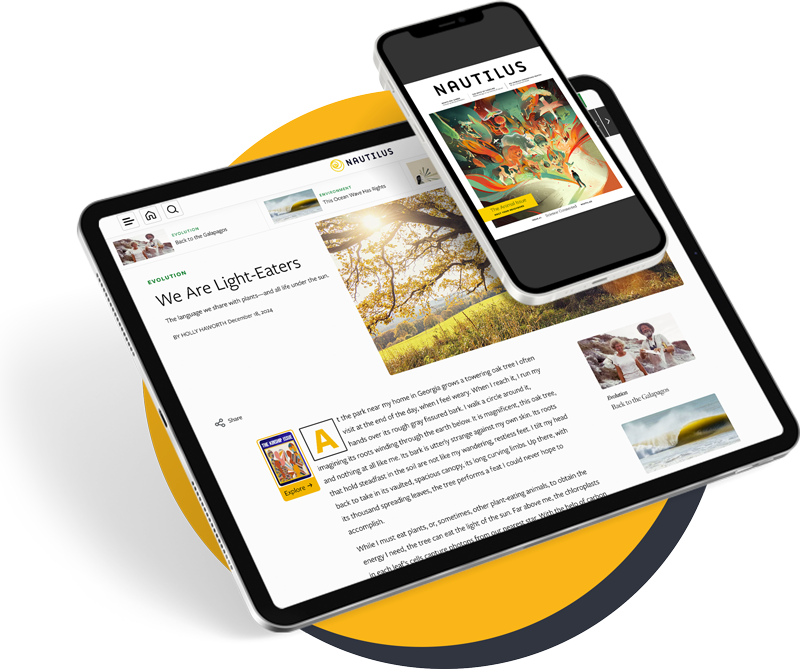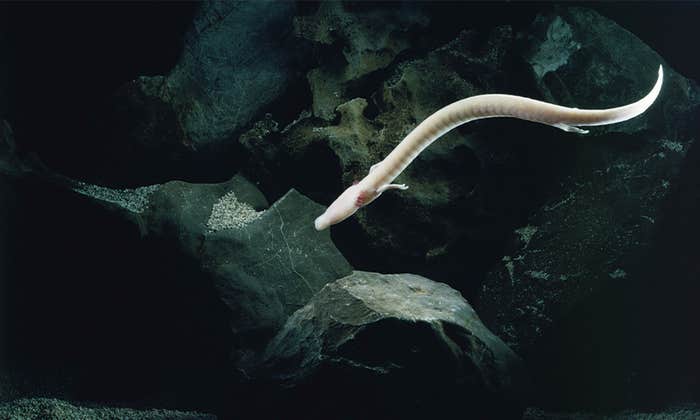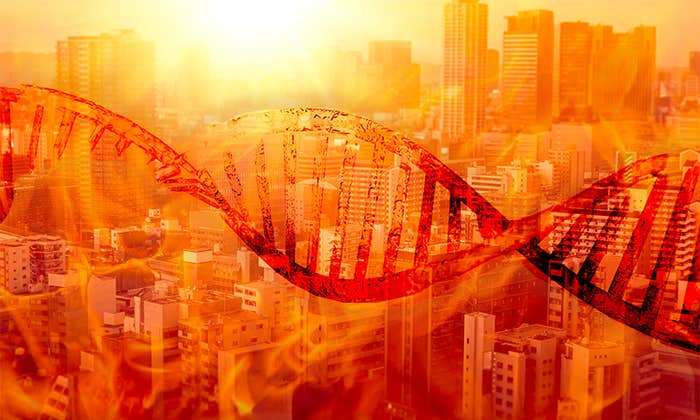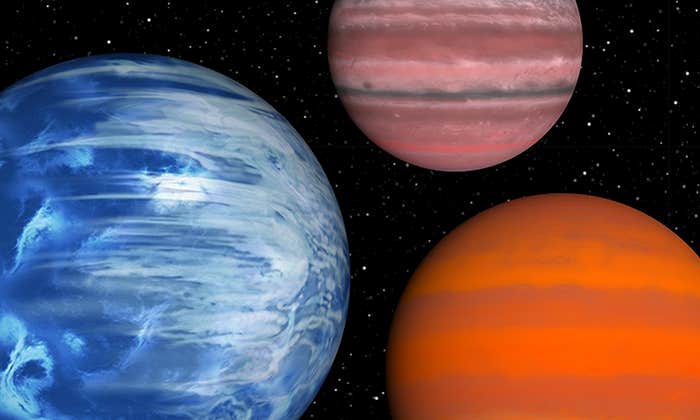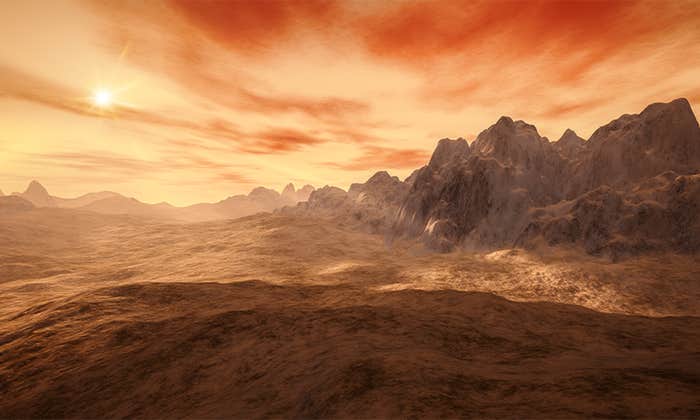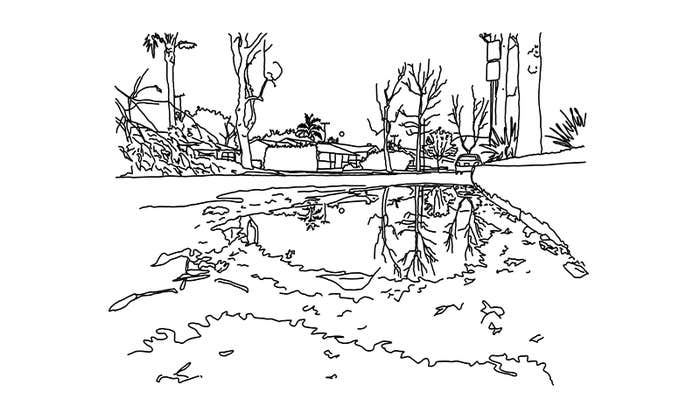To understand climate change is to understand the magnificence of life on Earth. You can’t know what’s wrong until you know what’s right.
Let’s talk about the beauty of greenhouse gases. Before the Industrial Revolution.
Nautilus premium members can listen to this story, ad-free.
Subscribe now to unlock Nautilus Narrations >
Nautilus members can listen to this story.
Subscribe now to unlock Nautilus Narrations >
Everything radiates light into the world. There are two kinds of light, visible and invisible. The invisible includes infrared light, emitted by Earth into the atmosphere, the column of sky above us.
Here’s Earth scientist Kate Marvel:
“We exist only because the sky does. A tiny fraction of our atmosphere consists of molecules that absorb infrared light. These are the naturally occurring greenhouse gases: water vapor, carbon dioxide, methane, and nitrous oxide. They capture Earth’s outgoing light because they can dance.”
When the dance stops, light is spread out in every direction. Despite making up less than half a percent of the atmosphere, natural greenhouse gases raised the planet’s temperature to 60 degrees Fahrenheit. That was the recipe for us. The laws of physics are some strange magic.
Marvel again:
“Take one ordinary star. Add a small rock 94 million miles away. If the rock is too cold, add a sky. Then watch as the magic happens. The sun shines, the planet tries to return its borrowed light to space, and little dancing gases in the atmosphere play a constant game of catch and release, throwing some of the outgoing light back down to its surface. The temperature rises and stabilizes, the rock swings round its mediocre little star, and all the stories on Earth begin.”
Marvel always wanted to tell stories. She started college focused on English and history. An astronomy class opened her eyes to the power and mystery of physics, and she earned a Ph.D. in theoretical physics at Cambridge University. Under England’s cloudy skies, she realized theoretical cosmology was not a sunny job industry; plus, she wanted to do something useful for the world. She struck up a conversation with a famous climate scientist. “What are you, stupid? Go work on climate,” he told her kindly.
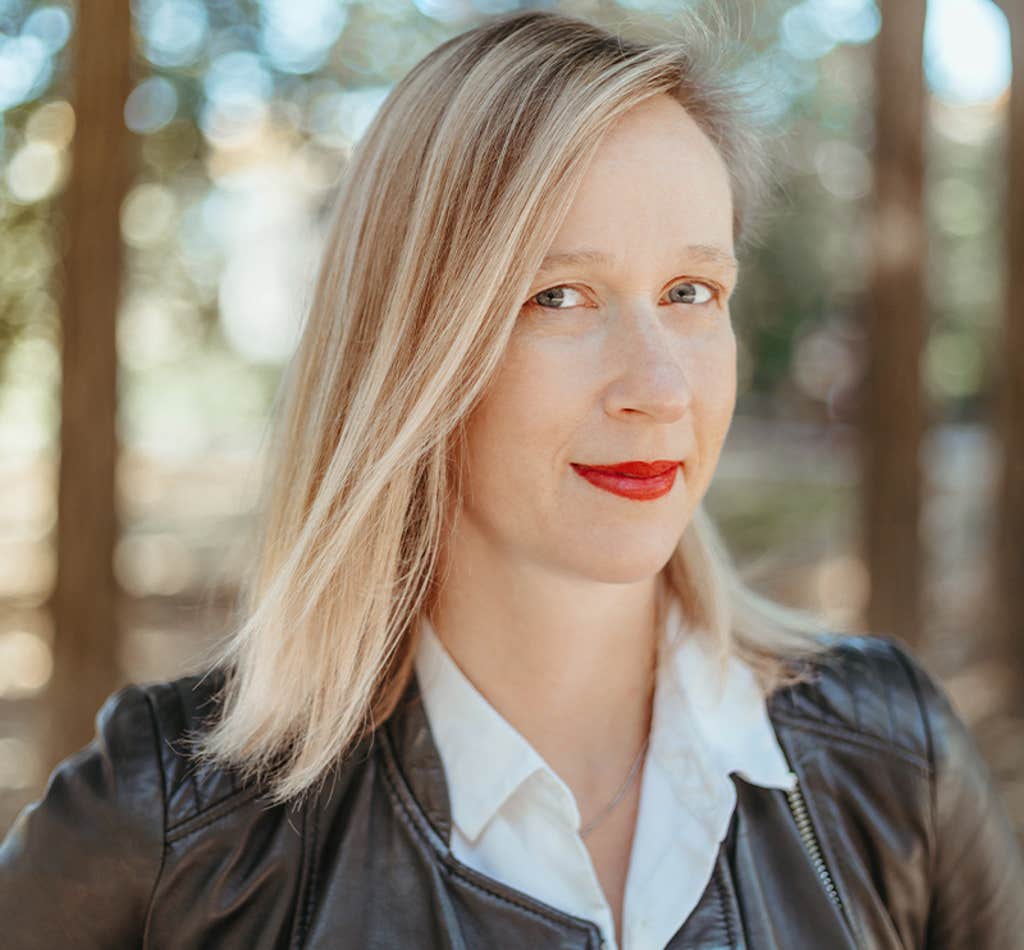
She did. “I thought climate science was the most interesting thing in the world,” Marvel said to me recently. (Today she is a research scientist at NASA, speaking for herself, not the agency.) “This is what I had to write about.”
This June, Marvel published her first book, Human Nature: Nine Ways to Feel About Our Changing Planet. It’s the most original book on climate science I know. It makes you feel as much about the climate as the change. And the change is charged with emotion. The book is structured in nine chapters, each named for an emotion, including wonder, anger, hope, and love. Aren’t scientists supposed to be neutral and objective? “I can’t be,” Marvel writes. “I need to declare a conflict of interest regarding Earth: Everyone I love lives here.”
Marvel writes with a naturally wry tone, as much novelist as scientist. She blends stories from movies and ancient myths into her explications of the natural forces that make Earth habitable, and the human forces making it less so. At one point, Marvel breaks into a screenwriter and offers a sample script.
INT. UNITED NATIONS BREAK ROOM—DAY
The WORLD LEADERS are milling around after a long shift at the UNITED NATIONS. The room is slightly too small for such a large crowd, and somebody (probably the SWEDES) has finished the entire pot of coffee and forgotten to make another one, so there’s only the orange-lidded decaf pot left. But no one seems to mind. The mood is cheerful. It’s been a successful meeting.
HEAD OF THE AFRICAN UNION
I’m so glad we solved climate change. That was a close one!
POPE
Yes, we should always listen to the scientists. It was very nice of them to warn us.
“Listen to the scientists.” Hahaha! Good one, Kate.
In 2019, Marvel testified at the U.S. House of Representatives. She explained to Congress members that human activities—primarily burning fossil fuel—have increased atmospheric carbon dioxide levels by 45 percent since the beginning of the Industrial Revolution. The increase has raised global temperatures and sea levels, intensified hurricanes and wildfires. Current trends of burning fossil fuel “will be at best economically devastating for many, and at worst catastrophic for all.” As a scientist, she said, “I can only tell you what the climate consequences of those choices might be. As a human being and a citizen, I hope that we will seize the opportunity to create the future we want.”
A Republican then took the floor to extoll coal power and oil drilling, Marvel writes in Human Nature. A Democrat got up to read a trite expression of concern. Marvel shares what she was thinking: “For God’s sake shut up.” It’s “clear these people require nothing from me, so I let my mind wallow for a bit and am surprised by the intensity of what bubbles up.”
What bubbles up is anger. Yes, scientists are supposed to float above personal biases and politics, Marvel writes. “But I don’t think that we enhance our credibility by pretending we feel nothing when we are ignored or belittled or insulted. It hardly makes us more honest to lie about our emotions. So here it is: I’m mad. I am angry at the cynicism, the lies, and the greed. I feel burning rage when I hear the same tired talking points, the falsehoods repeated credulously by people who should (and do) know better. I’m annoyed at how I and my fellow scientists have been treated. And I am absolutely furious when I see the uncertainty inherent in the scientific method twisted into something evil. Scientists don’t know everything, it’s true. But my God, I want to scream, we don’t know nothing.”
Writing can exorcise anger and apparently has for Marvel, who was sanguine during our conversation. I was the one fuming about the Trump administration taking an ax to climate change research and gutting environmental laws. As other wealthy nations invest in clean energies and gear up to retire fossil fuels, the U.S. is now driving a 1963 Chevy Biscayne that belches smoke and couldn’t be prouder and smugger about it. How does Marvel, who has devoted her life and career to producing painstakingly clear science that shows Earth is warming to life-threatening proportions, deal with this madness?
“This is not my first rodeo,” she replied calmly, harkening back to her Congressional testimony six years prior. “It’s a different flavor of the same thing. In that sense, I feel like, all right, we’ve done this before, we can get through this. People are still taking big, damaging, stupid swings at us. And they matter. They matter so much. But when you look at the people doing the actual nitty-gritty work of climate research, who are keeping the big picture in mind, I find that nourishing, even healing. I feel a deep sense of satisfaction being part of that.”
“Scientists don’t know everything, it’s true. But my God, we don’t know nothing.”
Marvel said she has been finding sustenance in the books she has been reading to her sons, aged 4 and 9. “The books always have this hero’s journey structure. There are no stories where the hero is faced with a challenge and says, ‘Nah, seems too hard.’ People do meet challenges, and that’s what I’m hanging on to.”
The sense of pride in doing good science is a wonderful quality of Human Nature, I said to Marvel. “I was thinking of the photographer who takes a picture of the Sistine Chapel so that everybody can see it,” she said. “I’m not likening my book to the Sistine Chapel! But I wanted to show this incredibly beautiful thing that humans have done in understanding the Earth.”
Besides, being a scold is the surefire wrong way to talk about climate change. “People are primed, ‘Oh, you’re a climate scientist, you’re going to come in guns blazing, you’re going to go through my trash and see if I’m recycling, and then you’re going to shame me,’” Marvel said. “But if you start with something like the fact that water on Earth came from space you plug into a primal curiosity that people have, a primal wonder of the world. It always blows my mind how powerful greenhouse gasses are. In the pre-industrial atmosphere, they’re less than a third of a percent, but they’re powerful enough to warm the Earth up. To know why the planet has a temperature at all is to me a good entry into the conversation.”
I was curious what Marvel thought of the criticism from self-styled climate realists, who admit humans are warming the planet but assert the problem is overblown. The thinking goes that public policy should direct resources to social problems like economic disparity and a cure for malaria rather than climate.
“I hope I am never elected to a world government that allocates this much for malaria and this much for climate change,” Marvel said. “But what I do know is that climate is the stage on which everything happens. The play and the actors and the weather may change, but climate is the stage. It’s the stage for agriculture, transport, trade. Changes are happening to the stage for virtually everything on Earth.”
What Marvel finds offensive, she said, is critics’ insidious practice of cherry-picking natural uncertainties in science to claim scientists can’t be confident that climate change is causing extreme weather. The criticism goes that deadly hurricanes, floods, and wildfires in recent years have merely been “seasonal weather events.”
“It’s just nonsense,” Marvel said. “The Climate Trends chapter in the U.S. National Climate Assessment says there is no detectable trend in the number of hurricanes, but there is a detectable trend in the number of extreme hurricanes and how fast they’re intensifying and how long they are lasting before they dissipate. I know that because I wrote it.”
Consider the recent, catastrophic floods. “It’s not new, shiny, cutting-edge science,” Marvel said. “This is physics so basic you can see it in everyday life. We know there’s more evaporation off warm water. A hot shower is going to fog up your bathroom more than a cold shower. When the ground is hot, that makes the air more buoyant and makes it rise more and so you get unstable conditions that lead to more precipitation, more storms. So, all these very basic physical things combine to prime the atmosphere for these heavy downpours we have been experiencing.”
“I’ll tell them that we humans must constantly tend to these bonds, thinking and changing.”
The canard that we need not worry now about climate change because people in the future will solve it, Marvel said, reminded her of an old joke. “A drowning man prays to God for help. A ship comes by and offers to rescue him, and the man says, ‘No, I’m waiting for God to save me.’ Another ship comes by and he says, ‘No, I’m waiting for God.’ And another ship comes by and he says the same thing. Then he drowns and goes to heaven. He asks God, ‘Why didn’t you save me?’ And God says, ‘I sent you three ships.’ We have to stop warming. But it won’t be by arguing that somebody’s going to figure it out eventually. We are that somebody.”
Marvel calls her book Human Nature to upend the belief that human nature is immutable, or more to the point, immutably bad. “I’ve had so many people tell me, ‘Oh, human nature means we can’t solve climate change because we’re too selfish, we’re too bad,’” she said. “That’s just another bad way of dealing with scary uncertainty. If you say people are bad, we’re all doomed, then you don’t have to think about the terrifying range of possibilities that we could do something. You don’t have to face this feeling of, we could do it, but maybe we won’t.”
In “Love,” the final chapter in Human Nature, Marvel gets personal about her own emotional decisions as a scientist, wife, and parent. She details her torn feelings over living near wilderness in California, where she was born, and the urban jungle in New York, her husband’s preference. (They live in Brooklyn.) She shares that she was diagnosed in 2022 with a blood clot in her brain, her treatment for it, and the lingering effects.
“I live now in a strange little limbo, never sure whether to expect a sudden catastrophe or simply the inevitable slow decline into something worse than now,” Marvel writes. “This is a feeling for which a career in climate science has prepared me well.”
Marvel’s admission about her health casts a powerful and moving spell over her book. Climate change feels personal and immediate. I asked Marvel why she decided to tell readers about the blood clot.
“I didn’t mean to at all,” she said. “It just kind of came out because when I was writing the last chapter, I wanted to talk about love, I wanted to talk about the interconnectedness of everything. As somebody who grew up with nature, that question weighed on me is, what is our relationship to nature? Are we part of nature? Are we separate from nature? What does it mean to be reading about the Sierra Nevada Mountains when you live in New York City? But going through this scare showed me that question is a silly one, a wrong one. Life is a complex renegotiation of our place in the world every single day.”
Marvel imagines passing that insight along to her sons. “I’ll take them to the mountains and through the city,” she writes. “We’ll talk about our place in the world, the physics that binds us tightly but passively to the whole of nature. I’ll tell them that we humans must constantly tend to these bonds, thinking and changing—as must happen in any relationship that lasts. If you love something, I’ll say, you must allow yourself to feel it. I do. I will.” ![]()
Read an excerpt from Human Nature by Kate Marvel, “What Poseidon Is Telling Us,” here.
Lead image: Rawpixel.com / Shutterstock




















